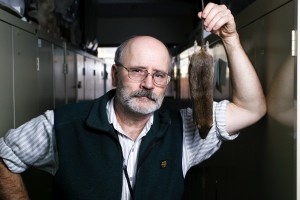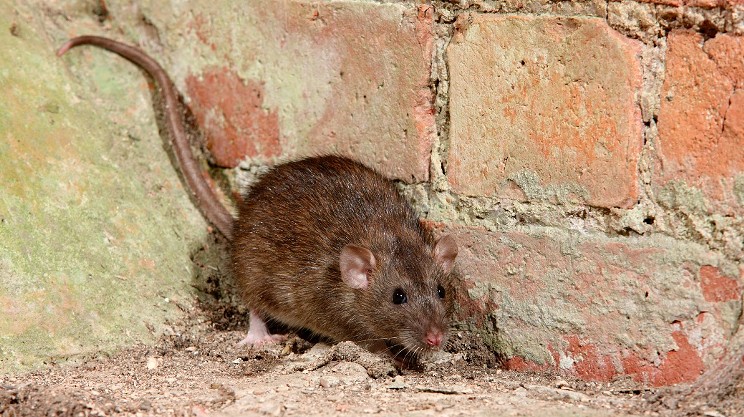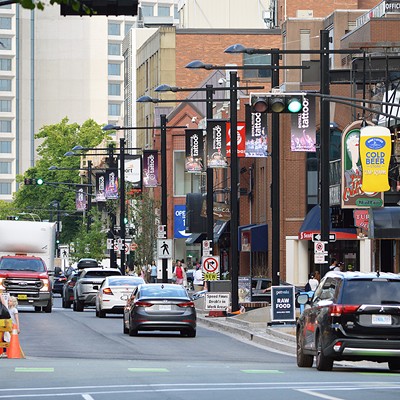This story starts in a west end Halifax toilet bowl, seven nights before Halloween.
A sleeping couple. Banging in the basement. Sophie, the cat, is “agitated.” The husband goes to check it out. But all the doors are locked and nothing is amiss. The banging stops. He goes back to bed. The wife sleeps through the whole thing. “The next morning he was painting our spare room down in the basement and he went into the bathroom...” Do you know where I’m going with this? I think you probably saw the image on these pages and you know where I’m going with this, right? OK. I just want to make sure. “...he opens the lid and there’s a dead rat in the toilet.” No. Really. “There was no screaming or shrieking. He handled it very diplomatically,” says Elaine Hart re-telling this, her rat chronicle. “He closed the lid again. And he called me to come downstairs and he said to me, ‘You know that urban legend about rats in toilets? Well it turns out it’s not an urban legend after all.’” Rats are “not very good swimmers,” according to Andrew Hebda, curator of zoology at the Nova Scotia Museum of Natural History. “But wait! Wait for the definition!” he says. “They can’t swim more than 100 or 200 metres. I can’t swim more than 100 or 200 metres.” The 1973 hour-long National Film Board documentary Ratopolis (gruesome! bloody! recommended!) is a dose more definitive. “Water is no obstacle where food is the goal,” drones narrator Budd Knapp over the image of a rat sniffing at, and then swimming through, a transparent, water-filled sewer line and toilet trap-way replica. “Both on the surface and underwater he shows perfect control of his respiratory rhythm.” And once he’s in the toilet bowl? “The endurance of rats in water has been tested at amazing lengths.” They can tread water for up to 80 hours. Now do you want the bad news? Adam Beaver has worked with Bremner’s Plumbing for 15 years. He “can count on one hand” the number of times he’s been called to install a backwater valve—-a regulator that costs $600 to $1,000 to install. Backwater valves prevent sewage from backing up into houses; they also stop rats from swimming up to say hello. But “since late spring,” Beaver says, “we’ve done probably seven or eight installations for that reason alone.” His most recent rat consultation was last week near Robie and Cunard. “There was one on Berlin Street,” he recalls, “a really extreme case, where the mother actually came into the basement apartment and had babies.” “More often,” Beaver says, consolingly, “you find a dead one in the toilet.” You’ve probably got a rat story, right? Just like that guy next to you, and your grandmother, and your doctor—-the pear-shaped one struggling to squeeze through the sewer grate on the Brunswick Street side of the Spring Garden Library; accidentally vacuuming one up in the spare room behind a bookcase and yanking it out of the clogged hose thinking it was a dirty sock; having your child step on the already-dead variety outside the Dalhousie Dentistry building during the 2007 Holiday Parade of Lights. Know why everyone’s got a rat story? Because rats are everywhere. Or, at least, everywhere there are humans. S. Anthony Barnett, in his 2001 book The Story of Rats, chills readers with reference to 55 diseases (“a certainly incomplete list”) carried by rodents. Our furry foes, he says, “make a global, largely underground network of disease vectors. Above ground, modern travel allows carriage of infection over thousands of kilometres in only a few hours.” But can’t humans be accused of the same crime? Really, rats are more like us than we would probably like to admit. Like us, they are omnivorous. And, like us, they mostly prefer densely populated areas with large artificial structures. And, again like us, they exhibit cracker-jack resilience and adaptability to new environments. But that’s not all. Rats are even smart—-or, at least, they are neophilic, as the term goes. They welcome novelty. In experiments, rats will learn to repeatedly turn on a light. It’s not because they can’t see well enough (though, in fact, their eyesight is Mister Magoo-terrible; it’s balanced by their heightened senses of smell, taste, hearing and touch). After some days, it’s as if the rats get bored—-they’ll start working to keep the lights turned off. In other experiments, rats will figure out how to push levers to produce noise. Dropped into a new environment, their first task is exploration, even if they haven’t eaten for some time and there is food for the taking. And their social structure mirrors our own. They congregate in colonies and set up hierarchies. Unlike wolves, there is usually no one rat leader. The Alphas comprise the highest stratum. Second-class Beta rats are tolerated, so long as they defer to the strength of the Alphas. Omegas make up the rest—-they are shunned and live on the colony’s outcroppings. Sound familiar? Next time you’re at the Museum of Natural History on Summer Street, look up. Two floors above Gus the tortoise and the museum gift shop sit half a million catalogued specimens. The collections floor is nearly refrigerator-cold, with wafts of moth balls and Vapona strips. It’s been the lair of avuncular-yet-fast-moving curator of zoology Andrew Hebda for 13 years. “I may get two or three calls a week this time of year about rats,” he says. The curator rockets over to a cabinet filled with herbarium sheets—-flattened flora, basically. In another spot: brain coral. Around the corner is the “wet” collection—-gooey beasties submerged in jars of what looks like left-over pickled-egg brine. In the opposite corner are rice- to tennis ball-sized insect and arachnid specimens. Preserved animals loiter here, there, everywhere—-juvenile eagles mounted with traditional taxidermy panache, a polar bear fixed in a frozen roar resting at an angle atop a cabinet. (“Customs seizure. A bear skin rug,” Hebda says, pointing.) Tucked in the middle of this dead animal wonderland is the “Rodentia” cabinet. Hebda slides out a drawer. I’m eye to eye with half a dozen stiff rats. These are study skins, flattened versions that can be easily stored in the drawers of the museum’s fire-proof metal cabinets. With study skins, animals’ insides, eyes and mouths are removed and replaced with cotton; the evicted skeletons accompany the skins. In this case, other skeletal bits are there, too. These are Norway rats, AKA, Rattus norvegicus. And that’s the kind we have here in Halifax—-a European import, just like our mice. Norways are the big, burly kind—-capable of growing 20 inches tip-to-tail. The cliche “a rat as big as a cat” fits here. But I like to picture it this way—-20 inches is the average length of a newborn baby. Black rats, or Rattus rattus, which were carriers of the bubonic plague that wiped out one quarter of the population of Europe and England in the 1300s, are smaller by about six inches on average. Which, I suppose, could be construed as a comforting characteristic. Black rats appeared in Halifax first around 1850 and later disappeared. They made a comeback starting in 1996 that lasted for only two years. Why the failure to flourish? Norways are bigger and stronger and refuse to mate with them. “Notice the characteristics,” Hebda says, pointing at the stiff Norways in the drawer. “The tail is completely nude; the ears are nude as well. These are well-fed, typically what most people would see. So we’re looking at, if you’re an inch person, that’s an eight-inch body and about a four-and-a-half-inch tail.” They are surprisingly downy. “Yep, well, fur is fur is fur is fur,” Hebda says. There’s nothing to be gleaned from the sites these rats were found other than a hint at their geographical ubiquitousness. One specimen, tagged in 1961, reads City of Halifax Dump. “So that one happens to be Africville,” says Hebda. Its neighbour, a 1973 vintage, is from Forest Road in Dartmouth. See, rats are truly equalizing forces. They don’t care where they live, so long as there’s food. They can burrow through concrete, and chew glass and metal. A Young Avenue mansion is no more formidable a fortress than a north Dartmouth public housing low-rise. But where do they like to live? Halifax’s rats started arriving by boat along with the first Europeans. “Almost all ships in the 19th century have cats aboard, and they don’t necessarily have them there for companionship. They are there specifically to deal with rats,” says Dan Conlin, curator of marine history at the Maritime Museum of the Atlantic on Lower Water Street. Conlin says he’s seen rat stories dozens of times in sailors’ biographies and accounts. Today, rats are still easy cargo. “Anybody who works on the waterfront can tell you,” Conlin says. “Harbour squirrels? I think that’s the name people use for them.” Next time you’re near the harbour, take a look at a docked ship and you might see a tire-sized disc halfway down its mooring line. It’s an excluder—-to stop rats from climbing the lines. Of course, we’ve already talked about their swimming abilities, so you can see the problem there. Conlin says the excluders are increasingly less common because crews use poison instead. “I think our ship Acadia,” he says of the museum’s harbour-docked exhibit steamship, “is one of the only ships in the harbour that still has a ship’s cat. Everybody else has turned to poison.” OK, so they come by boat. No surprise there. But then many stay on the waterfront. And it’s not because they like water, or that there’s more food down there. “If you go down Sackville Street, it’s quite a steep slope and then bang, you hit Lower Water Street and it’s very flat, right?” asks Andrew Hebda. Right. Well that’s because it’s fill. Halifax Harbour shorelines were originally all muddy beach lands. Today the edges are flat and vertical because they have been backfilled. “Anywhere you put in coarse rubble it puts in spaces and cracks that they can move through for protection,” says Hebda. “It gives them lots of places to climb. And now, we’ve got all sorts of other things using now, too. Downtown, and even up the Northwest Arm, we are picking up mink and weasels on a regular basis.” And where else is there a similar kind of loose ground? “OK, go up Coburg Road. What’s the first residence? Howe Hall? You know where the heating plant is in that area? Well the heating plant is the site of the old municipal dump. So, organic matter is not an issue, because that will break down with time, but dumps tend not to be well-compacted so you tend to have lots of spaces there. “In the summertime, especially just after the sun goes down, you can actually see them coming out of the sewers. You’re not looking at huge masses. Not the Pied Piper. But you can actually see them.” I staked out the crest of Coburg for this story but didn’t see any scurrying. Then again, Hebda said summer and this is December. They’re all staying warm in basements. “How can one make a census of small, nocturnal, well-camouflaged, burrowing animals?” wonders S. Anthony Barnett in The Story of Rats. Indeed. In Halifax, as far as Andrew Hebda knows, no one’s done a count. But there is an estimate: 75 rats per block. That’s the standard ballpark, Hebda says, for urban areas on North America’s eastern seaboard. That’s a roughly constant population, Hebda says. People just notice them more when they move seasonally—-like into houses when the frost hits—-or when they have to shuffle off to Buffalo because their habitat is disturbed by, say, construction. “When you’re blasting into bedrock, you’re altering the water courses and altering the rubble and the loose till. You’re displacing them. Or when someone goes and puts a subdivision in, all of a sudden you get an upsurge of people saying, ‘There’s a whole whack of rats here!’” Hebda says Harbour Solutions has displaced many a Halifax rat. “If you dig a trench down four or five or six metres, then everything in that area—-plus the vibrations—-they are going to move away from that.” Plumber Adam Beaver says he doesn’t know why his company has dealt with more holy-crackers-there’s-a-rat-in-my-toilet! complaints over the past six months than in the last 15 years combined but, he says, they’ve got some good guesses. “We’re thinking it probably has something to do with the Harbour Solutions Project driving the rodents inland a little farther. That’s the shop talk, anyway.” Susheel Arora thinks that’s bunk. Arora is the Halifax Regional Water Commission’s manager of wastewater services. He knows construction displaces rats. “Where I live? Penhorn Mall is all torn up right now. And there are tons of rats around there. Because of the construction.” But he doesn’t buy that Harbour Solutions is driving rats all the way up people’s toilets. “They would be washed down at some point and we would see them down against the screens.” He says people in his department haven’t been seeing more rats and he personally has never seen one in a sewer. “I was in tunnel very recently and I didn’t see any signs...and that’s a prominent rat area because the container pier is down there.” But what about Elaine Hart’s late-night lid-banging visitor? It swam up her toilet. Arora wonders: “Is she positive about that?” Before Harbour Solutions, the blame for rats was on chickens when Edinburgh Street resident Reg Harper made a complaint to the city about his neighbour Louise Hanavan’s three backyard chickens, telling the media: “I’ve got nothing against the chickens at all, but I got lots against the rats.” Before urban chickens, Haligonians routinely pointed the finger at municipal green bin composters, which have been blamed for providing food for the rats. Before that? It was the lack of municipal composting. In 1994, then-deputy mayor Tom Jeffrey told the Daily News Halifax City Council was looking into a mini rat boom with complaints coming in from Spryfield, Purcells Cove, Fairview, Clayton Park, downtown Halifax and the city’s north end. The culprit was a “smorgasbord of rotting food” from “overflowing garbage in the large refuse bins that service apartment buildings.” Andrew Hebda says none of these animal and infrastructure scapegoats do much to boost rat numbers. “If you have a richer source of food in one place, then that population? Rather than covering a 50-by-50 metre area, they stay in one place. But you are not introducing more rats.” So one day, you find a rat in your toilet. Heck, let’s imagine it’s not even that distressing. Let’s say you find a rat, just, say, in your house. There are three routes on the road to rodent elimination—-pay an exterminator, DIY or call the city, like Gloria McCluskey did. Yes, that Gloria McCluskey, councillor for Dartmouth Centre and former mayor of Dartmouth. McCluskey sits in her brick-walled office at Halifax City Hall. “I am 77!” she says with relish. “When I had the open-heart, they asked me and I said, I am 75! And I have a heart! For those who might question it.” The Dartmouth rat community might. “So, my phone rings,” says McCluskey, settling back in her chair to tell her rat story, “about 10:30 at night. I heard this, ‘Mommmmm...there’s a rat in my toilet!’” McCluskey grabbed her “fancy toilet plunger with a big pink flamingo on the handle,” and hopped in the car to her daughter’s Crichton Park split-level. “I went in the bathroom. Lifted the cover. Looked in the toilet and here’s this thing looking up at me.” McCluskey holds an invisible football in her hands. “Fairly big rat. And mean-looking! Well, you know, rats are mean-looking creatures. I said, ‘You have any Javex?’” ...La-la-la-la-la-la-la. I can’t hear you, Gloriaaaaaaa... “He didn’t do well with Javex.” OK. Moving on. “I just flushed the toilet. Sent him back down and out to Halifax Harbour, I suppose.” The next day, McCluskey called the city to bait the manholes. She recalls this was sometime between 1992 and 1996. “I was mayor,” she says, “and rat catcher besides.” These days it’s the same deal. HRM rat control isn’t preventive; it’s complaint-based. “It helps keep the cost down,” says Halifax Downtown councillor Dawn Sloane. Elaine Hart, whose west end Halifax rat started off this story, called the city, too. The dispatcher told her HRM would come and “bait the lines.” Hart wasn’t going to just cross her fingers and keep a blue-and-white Coleman cooler on her basement toilet forever. She hired a plumber to install one of the backwater valves Bremner’s Adam Beaver has installed an unprecedented number of this year. Gloria McCluskey has also had the opportunity to take the DIY approach to rat control. If in a different form. “When we were first married we bought an older home in downtown Dartmouth. And we were in bed one night and I felt something crawling across my face.” McCluskey tickles her pinky-brown nail-polished fingers over her blond bangs. “I jumped up and put on the light and what jumped off my bed but a BIG RAT!” The next day, McCluskey marched herself over to Walker’s Hardware on Portland Street and procured some Common Sense Rat Poison. “When we came home from work that night, I ran down into the basement and this thing was doing a lot of heavy breathing. Dying. Never had another one. That was 1952.” McCluskey says there’s no “real rat problem” in Dartmouth. And based on her anecdotal numbers, that sounds about right. When she was mayor she remembers there were rats in toilets on Limardo Drive and Chappell Street. As councillor, she has had to deal with rats in people’s garbage on Regent Drive, near Penhorn Mall. Lately, on the rat front, she hasn’t heard a squeak. John Zinck? Not so much. Zinck is Nova Scotia branch manager for Orkin Pest Control. He’s been in the rat biz for 15 years and has known many. “Biggest one I’ve seen is a pound-and-a-half to two pounds. A lot of people talk about rats that are three feet long and 20 pounds. There is no such thing. Mind you, at midnight scurrying across the floor, or in your toilet, they seem a lot bigger.” Zinck gets three or four toilet-rat calls a year. But, he says, “we have 14 technicians in HRM. And I’d say at least daily someone is dealing with a rat. At least.” Orkin is one of 13 pest control companies listed in the Yellow Pages. You can do that math however you like. The good news? “I have come across cases of mice where they have lived for six months inside a La-Z-Boy chair where the occupant snacks in the chair and is leaving enough food behind that the mouse is happy to come up, eat the food and go back in.” The population expands, Zinck says, before the humans really notice the problem. “With a rat, when he comes out for a bite, he tears the garbage apart underneath your sink and you know about it pretty quick.” Rats, he adds, are easier to trap and easier to poison. And yet people are so much more horrified by them than mice. “They are bigger,” Zinck concedes. (Up to 15 times, according to author Sandra Markle in her book Outside and Inside Rats and Mice.) But there’s more to it than size. Rats infest our food, spoiling grain stores with their droppings, which, in case you’re wondering, look like brown Contac-C cold caplets. Norways eat one-tenth of their weight in food a day—-for an average-sized one-pounder that’s 36 pounds a year. And Norways carry disease—-leptospirosis, Yersinia pestis (that’s plague), Lassa fever...you know what? Let’s not go any further. The other thing about rats? They are just so damn robust. Norways can climb four to five metres, hang with their semi-prehensile tails and employ their collapsible skeletons to squeeze through holes three-quarters of an inch in width. I just dug through the change in my sweatshirt pocket and measured. That’s the diameter of a nickel. Their average lifespan is eight to 11 months, but Norway rats breed like, well, you know what? Not even like rabbits. Like rats. Someone should change that cliche. They reach sexual maturity at three months, have no established breeding season and gestate for only 21 or 22 days with up to 10 in a litter. S. Anthony Barnett in The Story of Rats says females become receptive again to their mates’ three-second-long copulation only 21 hours after giving birth. “If she is inseminated while she is feeding a litter,” Barnett writes, “her next gestation is lengthened by delayed implantation of the embryos; but this only has a minor effect on her formidable fertility.” Interestingly, wide-scale poison assaults to decrease populations usually fail, according to Robert Sullivan in his 2004 book, Rats (for which the author spent a year in a forgotten New York alley to observe wild urban rats in their natural habitat). “When rats are killed off,” writes Sullivan, citing a 1950 report by American rat researcher and “founding father of modern rat studies” David E. Davis, “the pregnancy rates of the surviving rats doubles and the survivors rapidly gain weight.” It’s killing rats just to make room for stronger rats. Even under normal circumstances, a single pair of Norway rats, if all their young survived, could produce 20 million descendants in three years. “The news is simple,” says Andrew Hebda. “They are trying to make a living.” Ponder councillor Gloria McCluskey’s off-handed jab: Rats are mean-looking creatures. Are they? Or is McCluskey’s comment more meaningful than it comes off at first blush? Doesn’t it illustrate that perhaps our greatest objection to rats is rooted in our cultural sense of them? “The rat has not fared well in history,” writes Bill Buford in an October 1997 issue of The New Yorker. “It’s covert, like Claudius. It smells. It creeps like fate. It deserts the sinking ship. It’s history’s Judas, scratching away in the night.” Pest control boss John Zinck has thought about this, too. “If you go back through time—-even if you look at drawings and artwork—-the rats are the big mean guys who are coming to hurt humans. And that’s just a perception,” he says. “For the most part, they are not aggressive toward humans. They are going to try to run the other way if they can. They won’t come up and feed on you unless, let’s say, they are starving and you’re the last bit of food in the house—-your body.” I think that’s supposed to be reassuring. “The not-so-epic-seeming story of rats,” writes Rats author Robert Sullivan, “is close to one version of the epic story of man: When they arrive as immigrants to a newfound land, rats push out the creatures that have preceded them, multiply to such an extent as to stretch resources to the limit, consume their way toward famine—-a point at which they decline, until, once again, they are forced to fight, wander or die.” It is said that we hate in others the things we hate the most in ourselves. And this is no more true than it is in our disdain for our constant companion, the rat. And, after all, it could be worse. A short-tailed weasel showed up in a toilet bowl in the Truro area, the Museum of Natural History’s Andrew Hebda told me. “Rats are bad enough,” he wrote me later in a quick email. “You might not want to freak people out with other things coming in that way.” Lezlie Lowe is a freelance writer living in Ratifax.Rat city
They’re here...scurrying around Halifax, with their own network of tunnels
[
{
"name": "Air - Inline Content - Upper",
"component": "26908817",
"insertPoint": "1/4",
"requiredCountToDisplay": "8"
},{
"name": "Air - Inline Content - Middle",
"component": "26908818",
"insertPoint": "1/2",
"requiredCountToDisplay": "8"
},{
"name": "Air - Inline Content - Lower",
"component": "26908819",
"insertPoint": "100",
"requiredCountToDisplay": "1"
}
]














